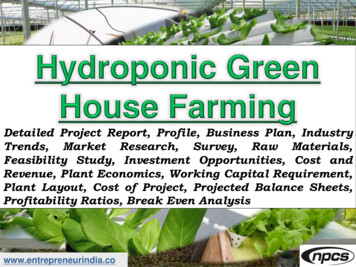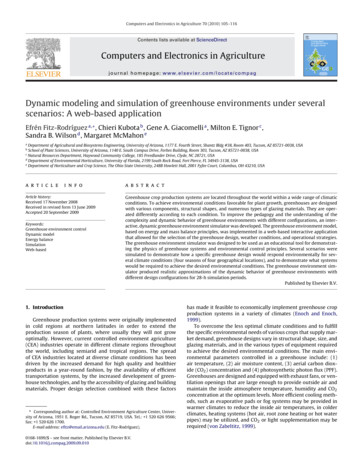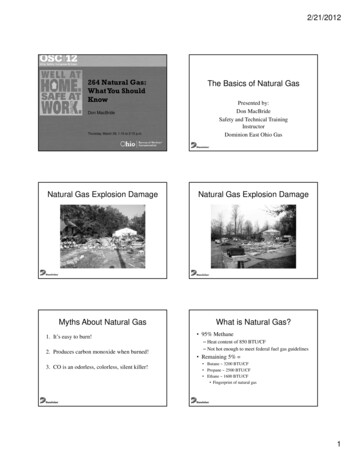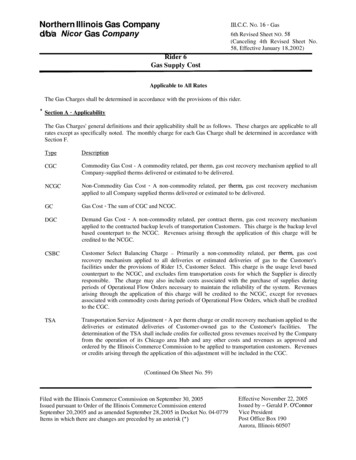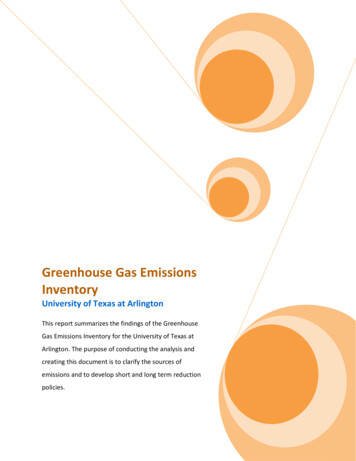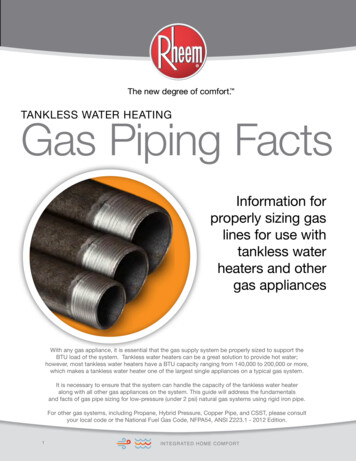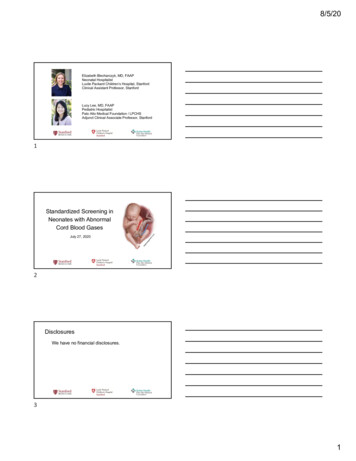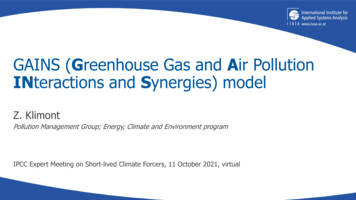
Transcription
GAINS (Greenhouse Gas and Air PollutionINteractions and Synergies) modelZ. KlimontPollution Management Group; Energy, Climate and Environment programIPCC Expert Meeting on Short-lived Climate Forcers, 11 October 2021, virtual
GAINS: A tool for a systematic assessment of thecost-effectiveness of emission control tml GAINS quantifies sectoral emission control potentials and costs, for exogenous (governmental, international agencies) activity projections. Search for least-cost mix of mitigation measures to meet air quality and/or GHG targets GAINS has global coverage - about 180 regions (several model implementations exist): Europe*, Asia (public free access) and for several countries/regions, e.g., Italy, Sweden, Netherlands, Ireland, Vietnam, South Africa, Hanoi, Beijing, Guateng(SA) (access for projects partners), and global (access for projects partners; sharing results with global/regional modelling community; also CEDS)* In early 2022, the domain will be extended to include all EECCA countries
GAINS model has been also applied and further developed at thenational levelGAINS also applied in several regional and global research activities: e.g., EU funded(ACCENT, CityZen, ECLIPSE), IEA, UNEP/CCAC, GEA, RCP8.5, EMF, SSPs; CEDS
The GAINS multi-pollutant/multi-effect framework(Greenhouse gas and Air pollution INteractions and Synergies)PM*(BC, SO2OC)Health impacts:PM (Loss in life expectancy) O3 (Premature mortality)Vegetation damage:O3 AcidificationEutrophicationNOxVOC NH3CO - /- N2O /-CH4 Climate impacts:Long-termNear-term forcingCO2HFCsPFCsSF6- * Includes PM2.5, PM10 as well as PM1, TSP; particle number calculation and Hg will be revised in 2023
GAINS model and emission inventories GAINS is not an emission inventory model We are not reviewing the inventories but use them(and other sources) to validate GAINS estimates;this might also lead to questioning assumptionsbehind inventories We try to understand and reproduce the inventory(within GAINS source and regional resolution) More and more effort to compare the results of GAINSwith ambient measurements to ‘validate’ theresults/assumptions GAINS requires often more data than Tier1/2inventories;* ‘Official reporting’ is referring to the high level Tier1/2 submitted/reported inventories
Calculating emissionsOver a 1000 ‘fuel-technology-emission reduction technology’ optionswhen accounting for all pollutantsEi Ei , j ,k ,mj ,k ,m Ai , j ,kef i , j ,k ( 1 effm )X i,j,k,mj ,k ,mi,j,k,mCountry, sector, fuel, abatement technologyEiEmissions in country iAActivity in a given sectorEf“Raw gas” emission factoreffmReduction efficiency of the abatement option mXmImplementation rate of the considered abatement measure m
Key elements of the emission calculation Activity data [A] – originates from international (e.g., IEA, FAO, Eurostat, IRF, USGS,etc.), national statistics, local studies, modelling work Emission factors [ef] (region-specific) originate from peer-reviewed studies,measurement campaigns (some are calculated within the model dependent ofdata/assumptions about e.g., sulfur, ash content, retention of S in ash, productivity,climatic conditions, etc.) Control measures efficiency [eff] – real-life performance assessment includedwhere possible, multipollutant aspects (including trade-offs) considered explicitly. Technology application rates [X] – own interpretation of policy, regional and localassessments, stakeholder consultations, etc.
Source structure (simplified key categories) Several fuels/activities – coal (5), oil (2), gas, biomass, renewables, electricity, nuclear, steel,aluminum, non-ferrous metals, cement, glass, refining, fertilizers, livestock ( 10), waste ( 5),paints, etc. Sectors – power plants (7), industry (boilers and furnaces but also 25 solvent use sectors),fossil fuel production and distribution, residential combustion (several categories for cooking andheating), brick production (several production processes), transport (several categories for roadand non-road; high emitters treated explicitly), enteric fermentation, rice production, wastetreatment (solid waste and waste water), refrigeration, air conditioning, etc. Control measures – various desulphurization measures, combustion modification, catalyticand non-catalytic controls, cyclones, ESP and fabric filters, improved stoves, pelletstoves/boilers, EURO stages, solvent substitution, manure storage options, efficient manureapplication, improved waste management and recycling, etc.
Source structure (simplified key categories) Several fuels/activities – coal (5), oil (2), gas, biomass, renewables, electricity, nuclear, steel,aluminum, non-ferrous metals, cement, glass, refining, fertilizers, livestock ( 10), waste ( 5),paints, etc. Sectors – power plants (7), industry (boilers and furnaces but also 25 solvent use sectors),fossil fuel production and distribution, residential combustion (several categories for cooking andheating), brick production (several production processes), transport (several categories for roadand non-road; high emitters treated explicitly), enteric fermentation, rice production, wastetreatment (solid waste and waste water), refrigeration, air conditioning, etc. Control measures – various desulphurization measures, combustion modification, catalyticand non-catalytic controls, cyclones, ESP and fabric filters, improved stoves, pelletstoves/boilers, EURO stages, solvent substitution, manure storage options, efficient manureapplication, improved waste management and recycling, etc.
GAINS is a collaborative effortData needsInitial IIASA version(international data)Improved with input from nationalexpertsBase year & projections ofeconomic activitiesData already implemented inGAINS (IEA, FAO, UN, IPCC,etc.)National data and projectionsEmission factorsCurrent GAINS database (peerreviewed and grey literature)Refinements based on localmeasurementsEmission controls;efficiencies, costsCurrent GAINS database (peerreviewed and grey literature)Refinement based on nationalinformationCurrent/maximumapplication of emissioncontrolsCurrent GAINS databases,including published info aboutlegislationLocal informationAtmospheric dispersionGAINS modelling based on global& regional atmospheric dispersionmodelLocal fine scale model utilizing localmonitoring campaigns; updated withfindings from monitoring and sourceapportionment studies (if available)Health impactsGlobal WHO methodologyLocal health statistics
Current status (1)https://gains.iiasa.ac.at/models/index.html Current release 4.01 Modelling periodo 1990 – 2015 (historical data in five-year intervals)o 2008, 2009, 2014, 2016 developed available globally and 2018 for some regionso 2020 – 2050 (projections in five-year intervals) More detailed info and publications can be found ato https://gains.iiasa.ac.at/models/gains resources.html Selected documentation papers Amann et al (2011) nt et al (2017) 7-8681-2017.htmlGomez-Sanabria et al (2018) Hoglund-Isaksson et al (2020) 20/ab7457
Current status (2)https://gains.iiasa.ac.at/models/index.html Uncertainty in model parameters is not explicitly included in the model Few assessments in the past for European model application Dedicated studies jointly with atmospheric modelling and remote sensing community evaluating results Gaps, ongoing and potential extensions CondensablesFurther improvements for solid waste management – electronic wasteNMVOC speciationTemporal distribution (currently annual with few sectors (e.g. residential heating) where regional (grid)specific patterns developed)Second-hand vehicles trade and performanceFocus on some regions that have had less data or difficult access to data(Central Asia, Africa, parts of Latin America)Spatial gridding – moving to 0.1 x 0.1 degree globally for all species
GAINS: A tool for a systematic assessment of the cost-effectiveness of emission control strategies GAINS quantifies sectoral emission control potentials and costs, for exogenous (governmental, international agencies) activity projections. Search for least-cost mix of mitigation measures to meet air quality and/or GHG targets


